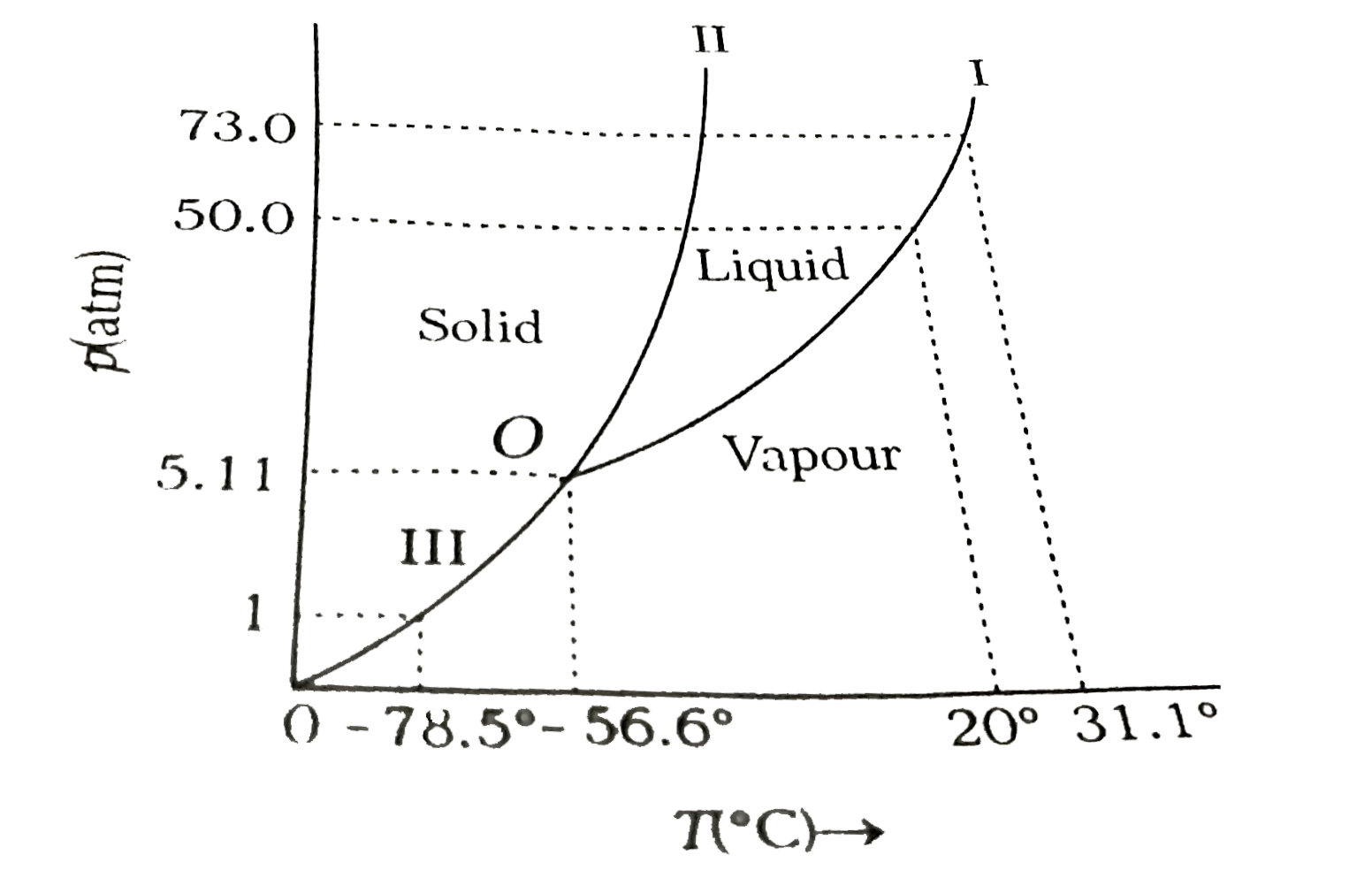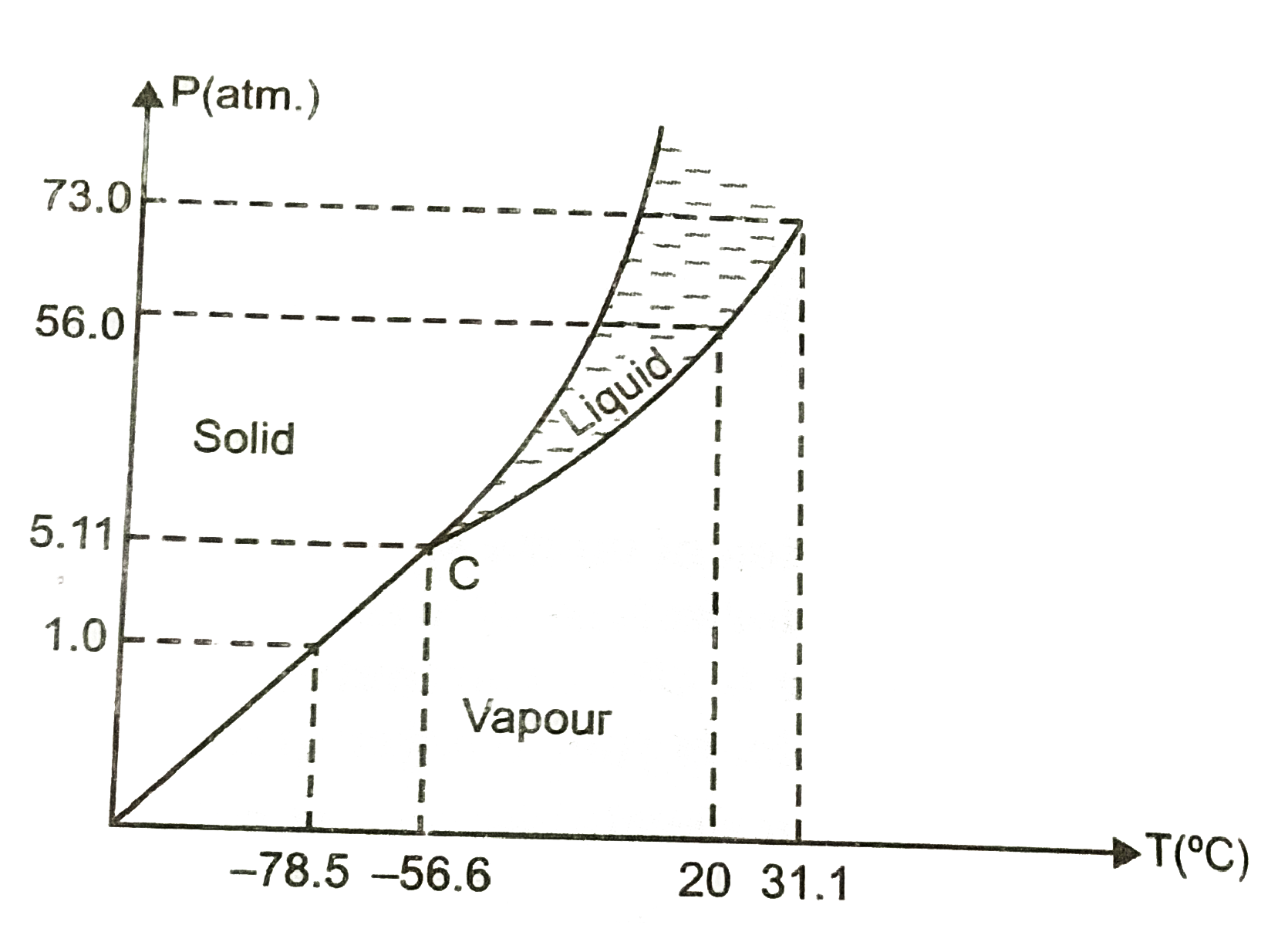Answer the following questions based on the P-T phase diagram of CO2:
Describe qualitatively the changes in a given mass of solid CO2 at 10 atm pressure and temperature −65∘C as it is heated up to room temperature at constant pressure.
It turns to liquid phase and then to vapour phase. The fusion and boiling points are where the horizontal line on P-T diagram at the constant pressure of 10 atm intersects the fusion and vaporisation curves.
Topper's Solved these Questions
- THERMAL PROPERTIME OF MATTERBOOK - NCERT BANGLISHCHAPTER - THERMAL PROPERTIME OF MATTEREXERCISE - EXERCISES
30 Videos
- SYSTEMS OF PARTICLES AND ROTATIONAL MOTIONBOOK - NCERT BANGLISHCHAPTER - SYSTEMS OF PARTICLES AND ROTATIONAL MOTIONEXERCISE - EXERCISES (TRUE OR FALSE)
3 Videos
- THERMODYNAMICS BOOK - NCERT BANGLISHCHAPTER - THERMODYNAMICS EXERCISE - EXERCISES
7 Videos
Similar Questions
Answer the following questions based on the P – T phase diagram of CO2:
(a) CO2 at 1 atm pressure and temperature–60∘C is compressed isothermally. Does it go through a liquid phase ?
(b) What happens when CO2 at 4 atm pressure is cooled from room temperature at constant pressure ?
(c) Describe qualitatively the changes in a given mass of solid CO2 at 10 atm pressure and temperature –65∘C as it is heated up to room temperature at constant pressure.
(d) CO2 is heated to a temperature 70∘C and compressed isothermally. What changes in its properties do you expect to observe ?

View SolutionAnswer the following questions based on the P – T phase diagram of CO2:
(a) CO2 at 1 atm pressure and temperature–60∘C is compressed isothermally. Does it go through a liquid phase ?
(b) What happens when CO2 at 4 atm pressure is cooled from room temperature at constant pressure ?
(c) Describe qualitatively the changes in a given mass of solid CO2 at 10 atm pressure and temperature –65∘C as it is heated up to room temperature at constant pressure.
(d) CO2 is heated to a temperature 70∘C and compressed isothermally. What changes in its properties do you expect to observe ?
View Solution
Knowledge Check
The pressure of gas at 100∘C is 2 atm. When the gas is heated at constant volume. At what temperature the pressure raises to 3 atm?
A286.5∘CB380.7∘CC420.2∘CD227.4∘CThe essential conditions for liquefaction of gases were discovered by Andrews in 1869 as a result of his study of pressure-volume-temperature relationship for CO2. If was found that above a certain temperature, it was impossible to liquefy a gas whatever the pressure was applied. The temperature below which the gas can be liquefied by the application of pressure alone is called critical temperature (Tc). The pressure required to liquefy a gas at this temperature is called the critical pressure (Pc). The volume occupied by one mole of the substance at the critical temperature and pressure is called critcal volume. Critical constants are related with van der Waals' constant as follows:
Vc=3b,Pc=a27b2,Tc=8a27Rb
GasesABCDPc(atm)2.2143545Tc(K)5.133127140
Which of the above gases cannot be liquefied at 100 K and 50 atm ?AD onlyBA onlyCA and BDC and D
Answer the following questions based on the P – T phase diagram of CO2:
(a) CO2 at 1 atm pressure and temperature–60∘C is compressed isothermally. Does it go through a liquid phase ?
(b) What happens when CO2 at 4 atm pressure is cooled from room temperature at constant pressure ?
(c) Describe qualitatively the changes in a given mass of solid CO2 at 10 atm pressure and temperature –65∘C as it is heated up to room temperature at constant pressure.
(d) CO2 is heated to a temperature 70∘C and compressed isothermally. What changes in its properties do you expect to observe ?
View SolutionAnswer the following question beased on tbhe P-T phase diagram of carbon dioxide.

(a) At what temperature and pressure can the solid, liquid and vapour phases of CO2 co-exist is equilibrium ? (b) What is the effect of decrease of pressure on the fusion and bolling point of CO2 ? (c ) What are the critical temperature and pressure for CO2 ? What is their significane ? (d) Is CO2 solid, liquid or gas at (a) −70∘C under 1 atm, (b) −60∘C under 10 atm, (c) 15∘C under 56 atm ?
View SolutionAnswer the following questions based on the p-T phase diagram of carbon dioxide as shown in the figure .
(i) At what temperature and pressure can the solid , liquid and vapour phases of C02 co-exist in equilibrium?
(ii) What is the effect of decrease of pressure on the fusion and boiling point of C02 ?
(iii) What are the critical temperature and pressure for C02 ? what is their significance ?
(iv) Is C02 solid , liquid, or gas at (a) −70∘Cunder 1 atm (b) −60∘C under 10 atm (c) 15∘C under 56 atm ?

View SolutionAnswer the following questions based on the p-T phase diagram of carbon dioxide as shown in the figure .
(i) At what temperature and pressure can the solid , liquid and vapour phases of C02 co-exist in equilibrium?
(ii) What is the effect of decrease of pressure on the fusion and boiling point of C02 ?
(iii) What are the critical temperature and pressure for C02 ? what is their significance ?
(iv) Is C02 solid , liquid, or gas at (a) −70∘Cunder 1 atm (b) −60∘C under 10 atm (c) 15∘C under 56 atm ?

View SolutionAnswer the following questions based on the p-T phase diagram of carbon dioxide as shown in the figure .
(i) At what temperature and pressure can the solid , liquid and vapour phases of C02 co-exist in equilibrium?
(ii) What is the effect of decrease of pressure on the fusion and boiling point of C02 ?
(iii) What are the critical temperature and pressure for C02 ? what is their significance ?
(iv) Is C02 solid , liquid, or gas at (a) −70∘Cunder 1 atm (b) −60∘C under 10 atm (c) 15∘C under 56 atm ?

View SolutionA given mass of ideal gas has volume V at pressure P and room temperature T. Its pressure is first increased by 50% and then decreased by 50% (both at constant temperature). The volume becomes
View Solution
